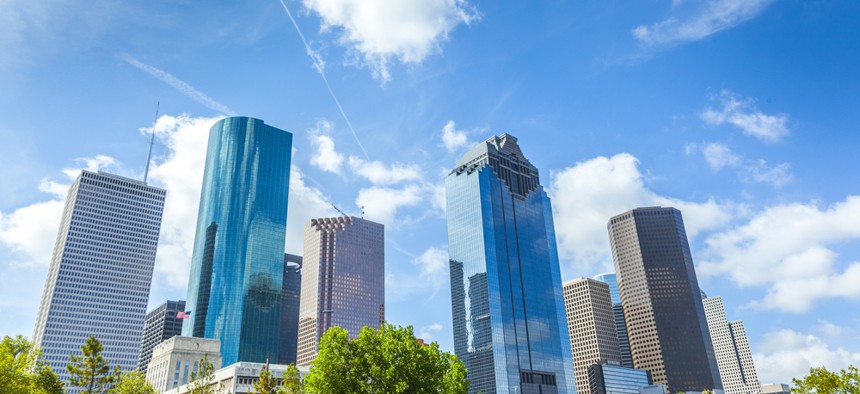Even as Sun Belt Cities Grow, Many Are Left Behind

Houston, Texas Jorg Hackemann / Shutterstock.com

Connecting state and local government leaders
Houston has seen both an explosion of jobs and a persistence of poverty.
HOUSTON—Fueled by the energy boom, this sprawling and steamy city has added significantly more jobs since 2000 than any other U.S. metropolitan area. Yet about one-sixth of its people remain mired in poverty—higher than the average for the nation's largest cities. And in a city where minority students now fill more than 90 percent of its public-school desks, it sometimes seems it might be easier for young people from the heavily Hispanic East End to walk to the moon than to climb to a job in one of its glassy downtown office towers.
In these jarring disparities, Houston crystallizes one of America's most pressing challenges: building an economy that broadly shares prosperity in a rapidly diversifying country. At a time when most of America's major international competitors are aging, Houston demonstrates how our kaleidoscopically diverse youth population could provide the nation an economic edge. But it also captures the risk the country faces if it does not equip more of those young people to succeed.
"We are really at the epicenter of what our country is going to make of this great opportunity of diversity," Bill White, the city's former mayor, told me at a recent National Journal forum. "We have a fantastic opportunity because we have such a young population. But if we neglect that opportunity, if we are content to fall behind other countries in education … we'll have a far different future."
White isn't exaggerating. The path for America's next generation is increasingly being set in fast-growing Sun Belt cities like Houston whose robust economies make them a magnet for young families. When Rolf Pendall and Margery Austin Turner at the nonpartisan Urban Institute recently crunched the numbers, they found that Houston and a complex of 14 other sun-splashed cities that resemble it demographically—a list that stretched from Charlotte, Raleigh, Atlanta, and Orlando in the East to Las Vegas, Denver, Dallas, Austin, and Phoenix in the West—generated fully half of the nation's new jobs from 2000 through 2013.
Even more striking was the dominant role of the "Houston cluster" in family formation. In 2000, these cities housed about one in every nine Americans younger than 20. But over the next decade these 15 cities became the nation's nursery, accounting for three-fourths of America's entire increase in young people through 2010; that growth was concentrated in minority families. This bounding baby boom came even as the combined youth population remained stagnant in the megacities along the coasts (like New York and Los Angeles) and the big Midwestern population centers.
The thriving Sun Belt centers have many assets: warm climates, generally affordable housing, and vibrant job growth. But as a group they generate more poverty and less upward mobility than the national average for cities, the Urban Institute's analysis found. That's an ominous pattern as more kids are reared in these places.
Houston's experience captures both sides of this ledger. The good news is that the flourishing energy industry not only helped the city add 530,000 jobs from 2000 to 2013, but also to steadily generate mid-wage positions—not just the very high- and low-end jobs evident in some other big cities.
But enormous educational disparities have locked out many of the city's residents from these opportunities. While three-fifths of Asians and about two-fifths of whites here hold at least a four-year college degree, that's true for only one-fifth of African-Americans and one-seventh of U.S.-born Hispanics. Not surprisingly, given those contrasts, the median income for African-Americans and Hispanics here is each less than half the level for whites.
Houston's public schools are showing several positive signs, including improving graduation rates. But the schools, coping with high poverty rates, aren't on track to close these gaps fast enough: blacks and Hispanics still badly trail whites in fourth- and eighth-grade reading and less than three-fourths of the city's ninth-graders graduate on time. "How are we going to have children … succeed in even mid-level skilled jobs if they cannot read manuals to repair the equipment?" says Juliet K. Stipeche, the dynamic East End-born president of the Houston school board. "So, we need help, we need investment."
Pendall, who directs the Urban Institute's metropolitan policy center, echoes Stipeche. Many of the growing Sun Belt metros, he says, are in states that have prioritized low taxes, squeezed "the basic investments in health and education for little children," and shown themselves willing to accept "extremely high rates of child poverty." In effect, he says, these states have relied on attracting well-trained workers from Northern states that spend more on equipping their kids. But as fertility rates in those Rust Belt states decline, Pendall predicts, "the gravy train will end and these states will need to invest in their young people."
The lesson of the burgeoning Sun Belt cities is that growth is necessary, but not sufficient, to expand the circle of opportunity. That also requires focused public investment to build more ladders for those willing to climb them. Absent that, even the rising tide in these prospering places will leave too many submerged.
(Image via Jorg Hackemann/Shutterstock.com)





